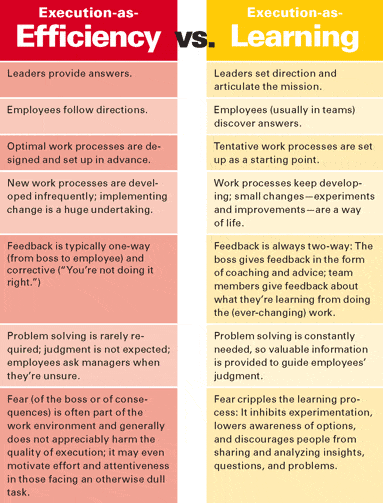Strategy is a word that can be found everywhere. In a recent post, I tried to provide an overview of the existing frameworks to define Corporate Strategy, and also have illustrated the tentative definition I tried to provide as part of the suggested Organisation Evolution Framework. As I read the book by Amy Edmondson, The Fearless Organization, I have encountered a concept that struck my curiosity. In an article written by Edmondson together with prof. Paul Verdin, and appeared on HBR, they developed a perspective that frames an organisation’s Strategy as a hypothesis rather than a plan.
Like all hypotheses, it starts with situation assessment and analysis –strategy’s classic tools. Also, like all hypotheses, it must be tested through action. When strategy is seen as a hypothesis to be continually tested, encounters with customers provide valuable data of ongoing interest to senior executives.
Amy Edmondson, The Fearless Organization
Strategy as a Hypothesis
The basis for this concept comes from one of the most diffused issues in management: the widely accepted view that Strategy and execution are separable activities set companies up for failure in a fast-paced world. In many failures of several companies, you can recognise precisely the sign of the above being a colossal mistake. Many companies develop strategies that are felt as sound by their executives. Performance gaps are seen as executions issues. A typical example: from the perspective of senior management at many companies, missing sales targets is a failure in the execution of an analytically sound strategy.
However, in a Volatile, Uncertain, Complex and Ambiguous (VUCA) world, there is nothing that can be set in stone. A company Strategy needs to be Adaptable as we have seen. And the best way to achieve this is to consider Strategy as a Hypothesis that needs to be tested, rather than as a plan to be executed. Which means that the organisation needs to embed a continuous listening capability towards the market, to ensure the testing works.
In a typical environment, the gap between customer behaviour tracked through the company’s metrics is seen as a Gap due to bad execution. With this approach, instead, execution is seen as a part of the Strategy, and the metrics and data coming from customers are used to adequately test the solidity of the Strategy and adapt it to the changing behaviours of customers. One of the most significant consequences of this is a change in the role of frontline employees.
The people on the front line who create and deliver products and services are privy to the most important strategic data the company has available. They know what customers want, what competitors are doing, and what the latest technology allows.
Amy Edmondson, The Fearless Organization
Strategy as Learning
The same authors call the above approach as Strategy as Learning. Its value sits in the capability for organisations to mitigate the risks of failing to integrate Strategy and execution through a deliberate and continual executive-learning process.
The key indicator of a strategy as learning approach lies in how managers interpret early signs of gaps between results and plans. Are they seen as evidence that people are underperforming? Or as data that indicates the initial assumptions were flawed, triggering further tests?
Amy C. Edmondson and Paul J. Verdin, Your Strategy Should Be a Hypothesis You Constantly Adjust, HBR November 2017
This means seeing Strategy as a Strategic Learning Process that actively seeks deviations that challenge assumptions that were used to develop the current strategy. We must welcome deviations and surprises because they allow learning, and allow the adaptation of the strategy to the new reality. In a context that changes too quickly, simply pushing harder on execution may only aggravate the problem if the issue is a wrong assumption underpinning the strategy. Or maybe the assumption has simply changed.
Facing Ambiguity
This means seeing Strategy as a Strategic Learning Process that actively seeks deviations that challenge assumptions that were used to develop the current Strategy. We must welcome variations and surprises because they allow learning, and will enable the adaptation of the Strategy to the new reality. In a context that changes too quickly, merely pushing harder on execution may only aggravate the problem if the issue is a wrong assumption underpinning the Strategy. Or maybe the premise has simply changed.
Facing Ambiguity
The biggest problem with the cleavage between Strategy and Execution happens when the situation is Ambiguous. If a company starts perceiving signals from the market that do not “align”, often this leads managers to ignore connected risks, and take a “wait-an-see-attitude”.
Yet, organisations that develop systematic capabilities for identifying, evaluating, and responding to vague threats are much better at avoiding severe problems than those that don’t is the main result of a research done in 2006 by Michael Roberto, Richard M.J. Bohmer and Amy C. Edmondson and published on HBR. They explain that three factors interplay in causing organisations to misread ambiguous threats: human cognition, group dynamics, and organisational culture.
- Human Cognition: the first factor stems from cognitive biases. We tend to protect the course of action we have developed with so much effort by suppressing subtle perceptions of dangers based on weak signals. And we usually tend to keep our commitment to the course of actions that we have invested time into.
- Group Dynamics: too often teams that deal with problems do not represent the necessary diversity, and are often “experts” far away from the real situations. Units, where Candid Communication and Psychological Safety are built, are needed to deal with ambiguous situations.
- Organisational Culture: many organisations develop dominant data-driven cultures where facts need to be proven with large sample-data and statistical or financial significance. This means that there is no place for ambiguous or incomplete data.
These three factors can be amplified when management in the organisation perceives execution through an “operational mindset”, approaching work as a routinised endeavour amenable to a standardised set of procedures and supported by detailed budgets and schedules. This alone means that any ambiguous data is interpreted as an execution gap. This brings up also more prominent issues. Inevitably, Strategy is perceived as an “imposition of certainty” which determines what data is included or excluded and how the included data is interpreted. The imposition of certainty can lead to the suppression of bad news and the removal of ambiguity.
Execution as Learning

The same Amy Edmondson had written another article where she has given a partial answer to this latter issue. In The Competitive Imperative of Learning published in 2008, she illustrates the difference precisely on this point. Instead of a purely operational mindset, organisations need to undertake an experimenting mindset, focused on testing and Learning.
First, organisations that focus on execution-as-learning use the best knowledge obtainable (which is understood to be a moving target) to inform the design of specific process guidelines. Second, they enable their employees to collaborate by making information available when and where it’s needed. Third, they routinely capture process data to discover how work is really being done. Finally, they study these data in an effort to find ways to improve. These four practices form the basis of a learning infrastructure that runs through the fabric of the organisation, making continual learning part of business as usual.
So, what is Strategy as Learning
The concept of Strategy as Learning works very well with some of the frameworks that underpin today’s new Ways of Working: Lean Startup Thinking and Agile. I also see a strong linkage with Design Thinking as a tool to be used for the definition of Strategy from the beginning, as it will allow constant testing of assumptions and interaction with end customers.
An example of this is the concept of “Continuous Delivery Pipeline” that is common in truly Agile Software Delivery. The Product Strategy is continuously adapted to the feedback received by the users, and the Strategy emerges from this. Another example is the “safe-to-fail” experiments that a lot of these models allow.
Strategy as Learning becomes, therefore, a capability for an organisation capable of making sense of the environment and its VUCA situations, and becomes the premise for creating a genuinely adaptable organisation.
Conclusion: Learning to Plan, or Planning to Learn?
The late economist Max Boisot felt that many of the models we use to simplify complexity were fragile scaffolding that often collapsed as new data emerged. In an economy built more and more on knowledge rather than physical assets, Boisot proposed that a safer orientation for companies to operate from was a position where information is regarded as more concrete, less abstract and to a certain extent more ephemeral – at any moment new data might disprove a set of assumptions. Boisot described this as moving away from reducing complexity in favour of absorbing complexity.
Our traditional organisational models follow instead of the archetypical factors of Weber’s Bureaucracy: they build organisational artefacts to reduce complexity. This is why Strategy is often seen as a plan only, based on several assumptions that isolate what needs to be done from the rest of the perceived noise.
Lean and Agile alone; however, don’t give a full answer. They provide useful tools, but they cannot accompany an entire organisation through the change steps needed. Leadership here is therefore vital, and that can truly create a culture that is in favour of absorbing complexity through continuous Learning. A leadership that is capable of addressing at the roots the cognitive bias that thinks of Strategy as an “imposition of certainty” and that can enable group dynamics that are value-creating.
What is new is the idea that closing the gap between strategy and execution may not be about better execution after all, but rather about better learning — about more dialogue between strategy and operations, a greater flow of information from customers to executives, and more experiments. In today’s fast-paced world, strategy as learning must go hand in hand with execution as learning — bypassing the idea that either a strategy or the execution is flawed — to recognize that both are necessarily flawed and both are valuable sources of learning, improvement, and reinvention.
Amy C. Edmondson and Paul J. Verdin, Your Strategy Should Be a Hypothesis You Constantly Adjust, HBR November 2017
Strategy as Learning becomes an essential piece of a puzzle we have already started building, that of a rebel organisation.
What do you think about this approach?

Cover Photo by Dmitry Ratushny on Unsplash

[…] this framework can help in shaping what we have seen, defined as Strategy as Learning. Imagine building a system where all these elements are not just an occasionally analysed when the […]
[…] sixth dilemma is at the core of how companies react to the “black swan” situation, and how an emergent strategy is the only way to reconcile disruption and […]
[…] is another critical aspect of this. We have already seen that Strategy can become, today, the way organisations Learn. Learning to Belong becomes a vital focus of any Inclusion Strategy as it means […]
[…] They also consider the fact that complete autonomy can lead to inconsistency. For this, they teach a model of socialisation and learning, that amplified shows how the right Strategy of Netflix is learning. […]
[…] Not many organisations are really able to make experimentation a big part of their way of working. However, focusing on experiments is transformational. Experiments become a healthy means of exploration of what is possible in the future. Some will fail; others will succeed. Learning becomes the key outcome of this process, an element we had already seen when we spoke about Strategy as Learning. […]